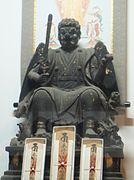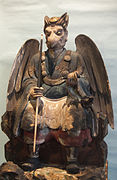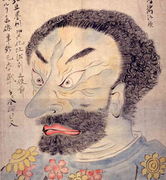Tengu

Tengu ( Japanese 天狗 , kana て ん ぐ ) is the name of a Japanese mythical creature that belongs to the category of Yōkai (monsters).
background
The Japanese name Tengu is the Sino-Japanese reading of the Chinese name Chinese 天狗 , Pinyin tiāngŏu , literally heaven dog . In Chinese sources, this is a dog-like creature, often depicted in connection with a falling star or a comet. It tracks the sun and moon, occasionally eating them up, causing the sky to darken. According to ancient sources, it sometimes comes down from the heavens under thunder, causing wars and other calamities. In Japan the characters are first found in the historical work Nihon Shoki, compiled in 720 . Here, too, a comet appears, followed by famine and the chaos of war. As a Japanese reading of the signs, however, the form Amakitsune (lit. "sky fox") is given, which introduces the fox, which is equipped with magical abilities in Japan. Since the end of the 10th century, the name Tengu can be found in stories ( Utsubo Monogatari , Genji Monogatari , etc.) as well as in dictionaries.
A second line of tradition begins with the mythical bird man Garuḍa (Japanese 迦 楼 羅 , Romaji Karura ; kana ガ ル ダ , Romaji Garuda ) of Hinduism . This developed in Buddhism to one of the group of the eight Deva belonging to the protective deity. This came via China to Japan (Chinese 迦 樓 羅 / 迦 楼 罗 , Jiālóuluó , Japanese Karura ). The oldest Japanese karura sculpture is in the Kofuku temple in Nara . It shows a human body with a bird's head in Chinese armor from the Tang period .
Development in Japan
The early formation of the Japanese ideas is not clear. Buddhist elements are probably mixed with ideas from the local Shinto . Illustrations such as the "Tengu picture scroll" ( Tengu sōshi emaki ) from the 13th century link the figure of the Tengu with (decadent) Buddhist monks. Since the 14th century, a human figure popular with Crows face / crow's head and wings in the costume of Yamabushi -Bergasketen of Shugendō , including the Tokin on his forehead. Sometimes one can also find figures who - probably influenced by Karura sculptures - wear Chinese armor. The Japanese Tengu hold swords, pilgrim sticks, scrolls, prayer chains or fans made of feathers with which they can cause violent winds. In the latter case, the wings are often omitted.
According to popular belief, tengu hatch from eggs. Their skin is deep red in color. Instead of hair, they grow feathers on their necks, shoulders and back of their arms, and all extremities end in bird's claws. They live in small groups in the mountains and rarely show themselves to people. At the top of their hierarchy is their king Sōjōbō . Lower forms such as the "Crow Tengu" ( Karasu-Tengu , 烏 天狗 , 鴉 天狗 ) or the " Tree Leaf Tengu" ( Konoha-Tengu , 木 の 葉 天狗 ) are usually the "Big Tengu" ( Dai-Tengu , also Ō-Tengu , 大 天狗 ) subordinate.
In the script Tengu meigi kō ( 天狗 名義 考 ) written by the monk Tainin during the Edo period, there is a number of nationally known Tengu who are worshiped as deities. They are often associated with a certain mountain, but also with fire or with Bishamon , in Buddhism the guardian of the northern direction:
- Sōjōbō ( 僧 正 坊 ) on Mount Kurama near Kyōto
- Tarōbō ( 太郎 坊 ) on Mount Atago in the north of Kyoto
- Jirōbō ( 二郎 坊 ) in the Hira Mountains west of Lake Biwa
- Sanjakubō ( 三尺 坊 ) on Mount Akiha ( Shizuoka Prefecture )
- Ryūhōbō ( 笠 鋒 坊 ) on Mount Kōmyō ( Niigata Prefecture )
- Buzenbō ( 豊 前 坊 ) on Mount Hiko on the border of the Fukuoka and Oita prefectures
- Hōkibō ( 伯 耆 坊 ) on Mount Daisen (Tottori Prefecture)
- Sankibō ( 三 鬼 坊 ) on the shrine island of Itsukushima
- Zenkibō ( 前 鬼 坊 ) on Mount Ōmine ( Nara Prefecture )
- Kōtenbō ( 高 天 坊 ) in Katsuragi (Nara Prefecture)
- Tsukuba-hōin ( 筑波 法 印 ) in the historic Hitachi Province
- Daranibō ( 陀羅尼 坊 ) on Mount Fuji
- Naigubu ( 内 供奉 ) on Mount Takao ( Hachioji )
- Sagamibō ( 相 模 坊 ) in Shiramine ( Ishikawa Prefecture )
- Saburō ( 三郎 ) on Mount Iizuna ( Nagano Prefecture )
- Ajari ( 阿闍梨 ) in the historical province of Higo
Originally, the Tengu were feared, which is why they sought to appease them with offerings. They caused obsession, attacked and kidnapped monks and children, and were aggressive and skillful with weapons. Minamoto no Yoshitsune is said to have learned the art of sword from Tengu Sōjōbō. With the early modern era, humorous aspects gained in importance. Quite a few Tengu now do all sorts of jokes. In many places, the beak also turned into a long nose with the corresponding sexual connotations. Because of their long noses, from a Japanese point of view, Europeans were occasionally represented as Tengu in the late Edo period.
For evocations, requests, etc. There are two mantras: On aromaya tengu sumanki sowaka ( オン·アロマヤ·テング·スマンキ·ソワカ ) and On hirahira ken hirakennō sowaka ( オン·ヒラヒラ·ケン·ヒラケンノウ·ソワカ ).
Thanks to their dazzling nature, their wildness and magical powers, Tengu under many names are now popular characters in manga , anime and computer games .
literature
- Alan E. Baklayan : War of the Mountain Demons - In the footsteps of the saint . Goldmann-Arkana Verlag, Munich 2009, ISBN 978-3-442-33845-0
- Issai Chozan: Zen and Sword in the Art of Combat. The Tengu geijutsuron and the wonderful way of the cat . Angkor Verlag: Frankfurt 2007, ISBN 3-936018-47-2 .
- Reinhard Kammer : ZEN in the art of wielding the sword. Discourse on the art of the mountain demons - Tengu-geijutsu-ron . Translation from Japanese, OW Barth Verlag: Bern, Munich, Vienna 1988, ISBN 3-502-64352-0 .
- Roald Knutsen: Tengu - The shamanic and esoteric origins of japanese martial arts . Global Oriental: Kent 2011, ISBN 978-1-906876-22-7 .
- Ulrich Pauly: Tengu. OAG Notes, No. 11, Nov. 2009, pp. 1ß-43 digitized
Web links
- Mark Schumacher: Tengu - Japanese Buddhist and Shinto Slayer of Vanity (Yamabushi Tengu, Karasu Tengu) - English, August 31, 2006
- Bernhard Scheid, " Tengu " ( Religion-in-Japan , July 19, 2012)
gallery
Sanjakubo statue at Hase-dera Temple ( Nara Prefecture )
The US commodore Matthew Perry , who pushed through the opening of Japan in 1854
Individual evidence
- ↑ Shiji (Tianguan, 5), Han Shu (Tianwen zhi)
- ↑ Nihon Shoki , chap. 23, Shōmei 9th year
- ↑ The dictionary Iroha jiruishō , compiled between 1177 and 1181 , probably therefore used the characters sky and fox ( 天 狐 ) for Tengu .
- ↑ More on this in Pauly (2009), pp. 40–42
- ↑ This sculpture probably once stood within the temple grounds and was placed in front of the entrance portal in the course of the separation of Buddhism and Shinto ( Shinbutsu-Bunri ) at the beginning of the Meiji period .
- ↑ The dimensions (28 × 25 × 58cm) and formatting show that this wooden sculpture was housed in the support shrine (Japanese oi ) of a mountain ascetic.







